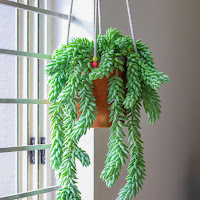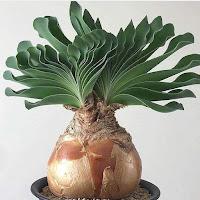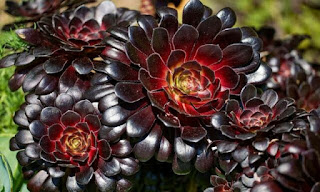BLACK: Plants in this hue are highly in demand for trendy Goth Gardens. These outdoor gardens amp up the spooky factor with black plants or plants with ominous names or histories. They often contain decorative pieces that continue the dark theme (here is one celebrity’s cool Goth Garden). You may not want to go all Goth, but decorating with black plants can be an elegant way to add a time-honored neutral to your décor. When choosing a black plant, you should be aware that not all of them start or stay black and that many need specific conditions to maintain their color. Just do your research and pick carefully and you will be rewarded with beguiling black beauties.

ZAMIOCULCAS ZAMIIFOLIA “RAVEN” - aka Raven ZZ. This plant is so easy to grow that some people claim it’s virtually impossible to kill. Be that as it may, this African native is definitely undemanding. It can survive quite well in very low light, really thrives when placed near direct sunlight, and is okay with irregular watering. Lighting does not affect the colors of this plant, the darkness of its glossy leaves increases over time from bright green to deep violet-black. Learn more here and watch a video here.

SINOCRASSULA YUNNANENIS – aka Chinese Jade. This perennial rosette succulent originated in the Yunnan province of China. It grows up to 4” in diameter and has densely packed, very dark green (close to black) leaves. If possible, put this beauty in full sun - it likes the warmth and the light helps it keep its darkest shade. For more on how to get the most from your Chinese Jade, read this and watch this short video.
 BLACK PATENT LEATHER COLEUS – aka Shiny Shoes – Most people are familiar with the coleus as a houseplant, but this variety has a special look. A native of Southeast Asia, this upright plant grows to about 18” x 18” and does little to no flowering –it’s all about the leaves. They have a shiny, bubbly texture and ruffled edges and are all-together delightful. Unlike some black plants, this one holds its color in the shade. There are several varieties of black coleus, some of which are hard to come by; so, if the one you want is not available, give another one a try. They are all beautiful. Here is a helpful article on growing coleus indoors.
BLACK PATENT LEATHER COLEUS – aka Shiny Shoes – Most people are familiar with the coleus as a houseplant, but this variety has a special look. A native of Southeast Asia, this upright plant grows to about 18” x 18” and does little to no flowering –it’s all about the leaves. They have a shiny, bubbly texture and ruffled edges and are all-together delightful. Unlike some black plants, this one holds its color in the shade. There are several varieties of black coleus, some of which are hard to come by; so, if the one you want is not available, give another one a try. They are all beautiful. Here is a helpful article on growing coleus indoors.
OPHIOPOGON PLANISCAPUS “NIGRESCENS” – aka Black Mondo Grass, Black Lilyturf, Black Dragon, Ebony Night, and more. If you’d like a change from run-of-the-mill houseplants, this flashy perennial from Japan really brings the drama. Black Mondo Grass sports dense, slender and long (8”-12”) leaves that arch gracefully out in all directions. This plant has traditionally been used as a groundcover in landscaping, but there’s no reason it can’t move indoors (here’s more on that). You can enjoy its foliage year-round, its small pale-pink flowers in the summer, and its glossy berries in the fall.
COLOCASIA ESCULENTA “BLACK MAGIC” – aka Black Elephant Ear, Taro, Taro Black Magic, Elephant Ears Black Magic. This beast of a plant can grow 3-6’ tall and produce leaves as long as 2’. Plants in both the Alocasia and Colocasia families are known as Elephant Ears; one difference is that the leaves of the Alocasia point up and the leaves of the Colocasia hang down. Elephant Ears are popular houseplants for their dramatic look and this variety will not disappoint - it will produce abundant, gorgeous deep purple/black leaves. Keep in mind that this plant grows from a bulb and may go dormant in winter. For more on growing this plant indoors, check out this article and for some more quick info, watch this video.
WHITE:
Attempting an all-white houseplant theme may be surprisingly challenging. The reason is pretty simple - most plants have green stems and/or foliage (at least at some stage). So, when searching for white plants, you will soon find yourself looking mostly at plants with white flowers. Of course, there are some exceptions (with Nature there always is); check out the White-stemmed Bramble (which looks more grey to me) and the Ghost Plant. With such a paucity of truly white plants, I’ve expanded my white selections below to include a couple of silver (again, some may call them grey) choices. As far as white-flowered plants go, I’ll leave it to you to sort through the many thousands to find the ones that suit you, should you go that route.

SRACHYS BYZANTINA – aka Lamb’s Ear – This pretty perennial has silvery leaves that are as soft and fuzzy as a lamb’s ear, and somewhat the same shape. These captivating leaves are what most people like about this plant, but in the summertime, it produces a tall flower spike with little purple blossoms that is equally interesting. Lamb’s Ear is usually used as a ground cover because it likes to spread, but it can be grown indoors if it’s given the proper conditions. Read more about how to grow this here.
 CALADIUMS– aka White Queen Caladium, Moonlight Caladium, Caladium Florida Moonlight, Angel Wings Caladium, and many more. These tropical perennials, with their elaborately mottled and almost translucent leaves, are real show-stoppers and with their nearly-endless varieties, there is something for every taste. Despite their huge popularity, these plants are not easy to keep healthy and are seasonal, so you will only get the foliage from spring to autumn. They grow from a tuber, however, so when winter approaches you can store the tubers and begin again the following spring. Here’s an article on how to grow them indoors and here's a video you may find interesting.
CALADIUMS– aka White Queen Caladium, Moonlight Caladium, Caladium Florida Moonlight, Angel Wings Caladium, and many more. These tropical perennials, with their elaborately mottled and almost translucent leaves, are real show-stoppers and with their nearly-endless varieties, there is something for every taste. Despite their huge popularity, these plants are not easy to keep healthy and are seasonal, so you will only get the foliage from spring to autumn. They grow from a tuber, however, so when winter approaches you can store the tubers and begin again the following spring. Here’s an article on how to grow them indoors and here's a video you may find interesting.
HELICHRYSUM PETIOLARE – aka Licorice Plant, Trailing Dusty Miller, Silver Bush. This is a small (9”-12”) perennial that prefers to grow out rather than up. The small, roundish leaves are plentiful and covered with soft grey hairs that shine with an iridescent glow. This plant is not the edible type of licorice, but it has a delicious fragrance nonetheless. There are several varieties of licorice with varying degrees of silver-shine; take your time and pick the one that is right for you. Here’s more on how to grow this in containers.

 A fun option to add white to any room without bringing in a plant itself is to bring in some dried accent pieces. You could go with White Pampas Grass - it is absolutely stunning. However, it can grow very tall (10’-13’), so it's not practical for most indoor settings. But, if you have a place to grow it on the patio or in the yard, you could harvest and dry the plumes for indoor decorations. According to this article, White Pampas Grass is the newest Instagram craze. (Here is more on how to grow them in containers.) Another fabulous option is the Money Plant (aka Lunaria Silver Dollar), these biennials have beautiful magenta flowers, but they are coveted for their silvery, translucent, coin-shaped dried seed pods. You can enjoy all stages of this outside plant and then bring the pods indoors to add glamour to your fall and winter décor.
A fun option to add white to any room without bringing in a plant itself is to bring in some dried accent pieces. You could go with White Pampas Grass - it is absolutely stunning. However, it can grow very tall (10’-13’), so it's not practical for most indoor settings. But, if you have a place to grow it on the patio or in the yard, you could harvest and dry the plumes for indoor decorations. According to this article, White Pampas Grass is the newest Instagram craze. (Here is more on how to grow them in containers.) Another fabulous option is the Money Plant (aka Lunaria Silver Dollar), these biennials have beautiful magenta flowers, but they are coveted for their silvery, translucent, coin-shaped dried seed pods. You can enjoy all stages of this outside plant and then bring the pods indoors to add glamour to your fall and winter décor. I hope this gets you thinking about some of the endless possibilities of using plants as a basis for interior design and that you will find your way to your own uniquely beautiful decor.
I hope this gets you thinking about some of the endless possibilities of using plants as a basis for interior design and that you will find your way to your own uniquely beautiful decor.Submitted by Pam


















